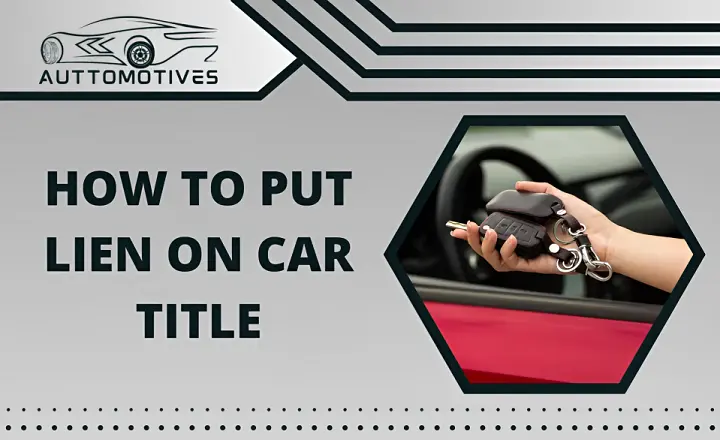If you want to secure a loan or sell your car, putting a lien on your title can provide added protection for both parties involved. But what exactly is a lien, and how to put lien on car title? Putting a lien on your car title involves filling out specific paperwork and submitting it to the appropriate authorities. In this step-by-step guide, we’ll explore everything you need to know about how to put a lien on a car title. A lien is a claim someone has on an asset until they receive payment for services rendered or debts owed.
How to Put Lien on Car Title?
From understanding the concept of liens and why they’re necessary to navigate the legal requirements and paperwork involved, we’ll break down each aspect of the process so that you can confidently move forward with securing your financial interests. Whether you’re a buyer or seller, understanding how to put a lien on a car title is essential to protect yourself when dealing with vehicle transactions. This process makes it easier for lenders to offer loans since they have an asset as security. Putting a lien on your car title should be done carefully and with proper knowledge of the procedure.

Here are some steps for how to do this.
Visit Your Relevant DMV Office:
When putting a lien on your car’s title, the first step is to find your relevant Department of Motor Vehicles. This department is responsible for issuing vehicle titles and can provide you with the necessary assistance to put a lien on your car. The easiest way to locate your DMV office is through dmv.org, which allows you to search for offices in your state by city name, state, or zip code.
Once you have located the nearest DMV office, you must visit them in person. While some states may allow for online applications, many require an in-person visit to complete this process. Therefore, when visiting the DMV, you must bring all necessary documentation and identification. During your visit, be sure to ask any questions that you may have regarding the lien process.
Get Title Application Form:
Getting a title application form from the DMV office is essential to put a lien on your car’s title. This form will allow you to establish legal ownership of your vehicle and protect it in case of any future disputes. You can obtain the required forms by visiting the nearest DMV office in your area or by downloading them online from their official website. When filling out the title application form, make sure that you provide accurate information about yourself and your vehicle.
You must also disclose any outstanding liens or loans associated with your car’s title. Once completed, submit the form and any applicable fees to the DMV office for processing. It’s important to note that you can only put a lien on your car’s title through this specific form. If you plan on selling or transferring ownership of your vehicle, having a clear and clean legal record is crucial.
Fill Up the Application:
Different states have different requirements when filling out a title application for your vehicle. There are some standard pieces of information that most states will need from you. These include details about your vehicle, such as the make, model, year, and VIN. You’ll also need to provide information about any liens on the vehicle, including the lien holder’s address and lien code.
Usually, your lending institution provides you with the necessary lien code. If you still need one, call them, and they should be able to assist you. Once you’ve filled out all the required information on the form, you must sign it before submitting it. By doing so, you’re indicating that you understand and agree to any terms and conditions associated with obtaining a title for your vehicle.
Submit the Application and Fee to the clerk:
This process involves filling out an application and submitting it to the office’s clerk along with the required fee. Once this is done, you can add a lien-holder to your title, which protects their interest in the vehicle until all outstanding debts are paid. It’s important to note that the fee for adding a lien-holder is not uniform across all states.
Some states may charge more than others, so it’s crucial to research beforehand and ensure you have enough funds to cover this cost. When submitting your application and fee to the clerk, double-check that all information is correct and up-to-date. Remember that adding a lien-holder does come with some drawbacks.
Get the Title Application Verified:
When getting your vehicle’s title application verified, there are a few things you need to keep in mind. First and foremost, you must pay a title application fee to the clerk at the DMV office. This fee is required for processing your application, and it is non-refundable. Once you have paid the fee, the clerk will ask for the lien documents that are necessary for verifying your application.
Lien documents are proof of ownership of your vehicle, and they also show any outstanding loans or debts against the vehicle. These documents are critical in verifying the accuracy of your title application. The clerk will review these documents thoroughly before filing your application with the DMV office. If everything checks out, you will receive a new title for your vehicle from the DMV office.
New Title Notice:
After applying to put a lien on your vehicle’s title, you will need to wait for a few days before the DMV office issues you a new title with the lien. Once this is done, you and your lender organization will receive a confirmation mail of the successful application. It is essential to note that the lender has legal ownership rights after putting a lien on your car’s title. You must consult with your lien partner before reselling or transferring ownership. Keeping in touch with them throughout the loan’s lifespan is best to avoid legal consequences or conflicts.
How to Sell a Car with a Lien?
Selling a car with a lien on its title differs from selling a normal one. A lien on a car’s title means that there is still money owed on the vehicle, and it can only be sold once the debt is paid off. It can create complications for individuals who need to sell their car but need help with how to do so with the existing lien.

There are different ways to sell a car with a lien on its title.
- One option is to pay off the remaining balance before putting the vehicle up for sale. While this may take time and effort, it ensures that potential buyers will be kept from outstanding debt.
- Another choice is to seek out private party lenders or dealerships specializing in buying vehicles with attached liens.
By Payoff Method:
If you still owe money on your car loan, you can sell the vehicle once you have paid all outstanding debts. The payoff method is an excellent way to get clear from your lender before selling your car. Pay off your car loan by gradually paying all the money owed before selling the vehicle. It can help ensure you receive the title as early as possible and avoid delays in transferring ownership of the car. Regular payments can also make it easier to budget and manage other expenses while working towards paying off your loan. If you have enough funds, consider paying off the entire lien in a single go.
Sell Via a Dealer:
Selling a car with a lien title can be a hassle, especially if you’re unfamiliar with the process. Fortunately, involving a dealer in the sale can make things much more manageable. One significant advantage of working with a dealer is that they can help you pay off the remaining loan balance on your car instantly. It means that once you sell your car to them, they’ll take care of all the financial transactions related to the sale.
Selling your car through a dealer is that they offer to give you additional funds for purchasing another vehicle. If your car’s value exceeds what’s owed, some dealers may be willing to pay you more than what’s required so that you can use those funds towards buying another vehicle. It’s important to remember that this will only sometimes be an option and will largely depend on the specific dealership.
Sell to the Lender Company:
Several options are available if you need help to meet your debt repayment requirements. One of these is selling your car to the relevant lender. It can be a good option if you have a high-value vehicle and owe significant money. By selling your car to the lender, they will take ownership of the vehicle and pay off any outstanding debts that you have on it. If the car has additional equity, they will pay you this amount.
The process involves signing over the title transfer papers as per state rules after clearing any liens. If you have a private purchaser ready to buy your vehicle, this could also be an option worth considering. In this case, the buyer will compensate for your lien amount and get a clear title once you’ve paid off your debt via the sale price.
Conclusion:
Understanding the process of putting a lien on your car’s title is crucial to ensure you can quickly secure a loan or sell your vehicle. It is important to note that the specific procedures and requirements may differ depending on the state where you reside. You should contact your local DMV office for guidance in the process. By following the outlined method discussed above, you will easily navigate the process of how to Put Lien on car Title and ensure that all necessary steps are taken. Take action today and put a lien on your vehicle’s title to secure your financial interests!
Frequently Asked Questions:
How do I know if I have a lien on my car?
If you have a title to your car, you have a lien. If you don’t have a title, the lender has the lien.
What are the steps involved in putting a lien on a car title?
To put a lien on a car title, you must submit a Notice of Lien to the Department of Motor Vehicles (DMV). The DMV will then send you a Lien Certificate, which you must present to the creditor when trying to take possession of the car.
What is a “lien,” and what does it mean for a car?
A lien is a legal document that gives the creditor, such as a car loan company, a claim on the property or assets of the debtor. The creditor can then take whatever necessary action to get its money, including selling the property or seizing the debtor’s wages.

